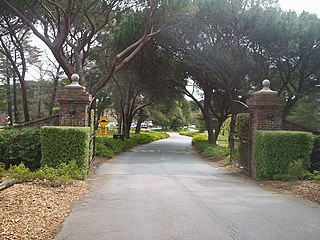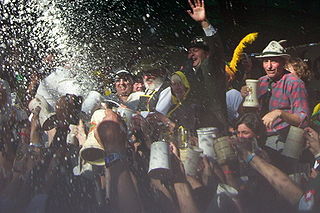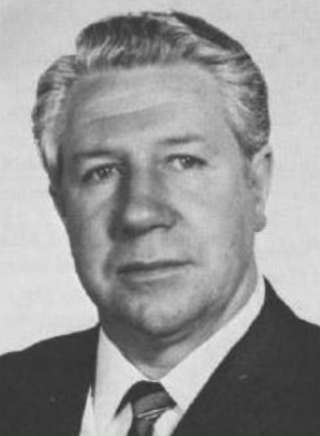
Queanbeyan is a city in the south-eastern region of New South Wales, Australia, located adjacent to the Australian Capital Territory in the Southern Tablelands region. Located on the Queanbeyan River, the city is the council seat of the Queanbeyan-Palerang Regional Council. At the 2021 census, the Queanbeyan part of the Canberra–Queanbeyan built-up area had a population of 37,511.

The Canberra Golf Club, later known as the Royal Canberra Golf Club, was formed in 1926. Its original grounds were behind the Hotel Canberra on the river flats on both sides of the Molonglo River.
Raymond James Bright is a former Australian Test and One Day International cricketer from Victoria. He was a left arm spin bowler and lower order batsman who captained Victoria for a number of seasons. He was also an Australian vice-captain.
Rodney Malcolm Hogg is a former Victorian, South Australian and Australian cricketer. He was a fast bowler. Hogg played in 38 Test matches and 71 One Day Internationals between 1978 and 1985. In Tests he took 123 wickets at an average of 28.47. He is best remembered for taking 41 wickets in his first six tests during the 1978–79 Ashes.
Geoffrey Dymock is a former Australian international cricketer. He played in 21 Test matches and 15 One Day Internationals between 1974 and 1980. On his debut, he took five wickets in the second innings against New Zealand in Adelaide in 1974. He was the third bowler to dismiss all eleven opposition players in a Test match, and remains one of only six bowlers to have achieved this.
Gary John Gilmour was an Australian cricketer who played in 15 Tests and 5 One Day Internationals (ODIs) between 1973 and 1977.
Glenn Samuel Trimble is a former cricketer who represented Australia and Queensland. A batsman who preferred to play straight, and a part-time medium pace bowler, Trimble was a regular member of the Queensland side in the mid-1980s, and won an Esso Scholarship in 1986, playing with the Essex County Cricket Club Second XI in England.

Australian rules football in the Australian Capital Territory has been played continuously since 1911 and was the most popular football code in the nation's capital Canberra between 1978 and 1982. The current governing body is AFL NSW/ACT established in 1999.
Royal Melbourne Golf Club is a 36-hole golf club in Australia, located in Black Rock, Victoria, a suburb southeast of Melbourne. Its West and East courses are respectively ranked number 1 and 6 in Australia. The West course is ranked in the top-five courses in the world. Founded 131 years ago in 1891, it is Australia's oldest extant and continually existing golf club. Unlike many metropolitan golf venues, The Royal Melbourne Golf Club has a capacity for 15,000 spectators.
The Canberra Region Rugby League competition is more commonly known as the Canberra Raiders Cup, covering the Australian Capital Territory and surrounding New South Wales towns Queanbeyan, Goulburn and Yass. The competition is run under the auspices of the Country Rugby League and players are eligible for selection in the Canberra Division of the CRL Tier 1 Divisional Championships. The Canberra district competition has an under 19s, reserve and first grade competitions.

The Oktoberfest is a two-week festival held each year in Munich, Germany during late September and early October. It is attended by six million people each year and has inspired numerous similar events using the name Oktoberfest in Germany and around the world, many of which were founded by German immigrants or their descendants.

The Australian PGA Championship is a golf tournament on the PGA Tour of Australasia. It is the home tournament of the Australian PGA. Since 2000 it has been held in the South East Queensland region. The tournament was part of the OneAsia Tour from 2009 to 2014, and from 2015 to 2019 it was co-sanctioned with the European Tour.

Horace James Garrick was an Australian politician. He was an Australian Labor Party member of the Australian House of Representatives from 1969 to 1977, representing the electorate of Batman.

Patrick James S. "Paddy" Carew was an Australian rugby union national and state representative and a first-class cricketer and public servant. He was born in Pine Mountain in southern Queensland.
Wednesday Theatre is a 1960s Australian anthology show which aired on the ABC.
The Wills Masters was a golf tournament held in Australia and played annually from 1963 to 1975. The Wills Classic had been held in Australia from 1960 and 1962. Total prize money from 1963 to 1965 was A£4,000. In 1966 and 1967 it was A$8,000 increasing to A$10,000 in 1968, A$20,000 from 1969 to 1971, A$25,000 in 1972 and A$35,000 from 1973 to 1975. The sponsor was W.D. & H.O. Wills, a cigarette manufacturer.
The Johnnie Walker Australian Classic was a golf tournament held in Australia from 1988 to 1992. It was first played as the Bicentennial Classic to celebrate the Australian Bicentenary. From 1989 it was sponsored by United Distillers, using their Johnnie Walker Scotch whisky brand, and officially titled as the Johnnie Walker Australian Classic, and then the Johnnie Walker Classic from 1991.

The Queanbeyan railway bridges over Queanbeyan and Molonglo Rivers are two heritage-listed railway bridges that carry the Bombala railway line in the Queanbeyan-Palerang Region local government area of New South Wales, Australia. Both bridges were built between 1926 and 1927. The westernmost bridge crosses the Queanbeyan River from Queanbeyan to Queanbeyan East at 35.3424°S 149.2317°E, while the easternmost bridge crosses the Molonglo River at Burbong at 35.3371°S 149.3191°E. The two railway bridges are owned by RailCorp, an agency of the Government of New South Wales. Together, the two bridges were added to the New South Wales State Heritage Register on 2 April 1999.
The Wattie's Tournament was a golf tournament held in New Zealand from 1963 to 1970. The event was generally hosted by Hastings Golf Club in Bridge Pā, except the 1969 event which was held at Gisborne. The 1963 tournament was held in September but later it was played in late November or in December. Bob Charles won the event four times. The event was sponsored by Wattie's.
The Australian Capital Territory Progress and Welfare Council was a peak co-ordination body of progress associations in the Australian Capital Territory. It also operated as a political party in the ACT in the period prior to self-government in 1989.









